by James Redin |
|
|
|
Although the machine attracted a lot of attention in those days, it did not get wide acceptance because it was expensive, unreliable as well as difficult to use and manufacture. By 1652 about 50 units had been made but less than 15 had been sold. Initially, Pascal got a lot of interest in his invention and he even obtained a "privilege" protection (medieval equivalent of a patent) for his idea in 1649, but his interest in science and "material" pursuits ended when he retreated to a Jansensist convent in 1655 concentrating all his attention on philosophy. He died in 1662. Even at the beginning of the 20th Century, several companies introduced models based directly on Pascal's design. One example is the Lightning Portable Adder introduced in 1908 by the Lightning Adding Machine Co. of Los Angeles. Another example is the Addometer introduced in 1920 by the Reliable Typewriter and Adding Machine Co. of Chicago. None of them achieved commercial success.
Like Pascal, Leibniz was a child prodigy. He learned Latin by the age of 8 and got his second doctorate when he was 19. As soon as he knew about Pascal’s design, he absorbed all its details and improved the design so as to allow for multiplication and division. By 1674 his design was complete and he named this machine the Stepped Reckoner; then he commissioned the building of a prototype to a craftsman from Paris named Olivier.
Although the concept of the Leibniz Wheel became well know among the scientific community, there is no evidence that more than two prototypes of this machine were ever made. Even though Leibniz was one of the most outstanding polymaths of his time, he died in poverty and unrewarded. His machine remained in the attic of the University of Göttingen until a worker found it in 1879 while fixing a leak in the roof. Now it is in the State Museum of Hanover; another one is in the Deutsches Museum in München. Pascal's and Leibniz’s designs were the basis for most of the mechanical calculators built during the 18th Century. Giovanni Poleni made one in 1709, Lépine in 1725, Antonius Braun in 1725, Jacob Leupold in 1727, Hillerin de Boistissandau in 1730, C.L. Gersten in 1735, Jacob Isaac Pereire in 1750, Phillip Mathieus Hahn in Germany in 1773. Charles, the third Earl Stanhope, of England, in 1775; Johan Helfreich Müller in 1783, Jacob Auch in 1790, and Reichhold in 1792. Special consideration deserves the Parson Phillip Mathieus Hahn (1730-1790) who developed in 1773 the first functional calculator based on Leibniz's Stepped Drum. Hahn's calculator had a set of 12 drums in a circular arrangement actuated by a crank located in the axis of the arrangement. Hahn made these machines until his death in 1790, however, his two sons and his brother-in-law, Johann Christopher Schuster, continued with the manufacture probably as late as 1820. By the end of the 18th Century, calculating machines were still curiosities used for display purposes, rather than for actual use. The limitations imposed by the technology made it impossible to meet Pascal's dream of making them a practical calculation device.
Like every successful product, the Thomas Machine had many clones, and the term Arithmometer became synonymous with four function calculating machine.
In 1892 Odhner sold his patent rights to Grimme, Natalis & Co. A.G. of Braunschweig for sale in Germany and some neighboring countries. This company manufactured the Odhner-type calculators under the name Brunsviga, and later, the company itself was named Brunsviga. 20,000 units were sold between 1892 and 1912. In 1917, the year of the Russian revolution, his son Alexander moved the production to Göteborg, Sweden, and sold the rights to manufacture this type of machine under the name Facit, which were produced until 1977. The quest for a keyboard Between 1850 and 1887, many attempts were made to develop a calculating machine that would use keys as means to enter data. In Europe, key-driven machines were made by V. Schilt (1851), F. Arzberger (1866), A. Stettner (1882), Bagge (1882), d’Azevedo (1884), Petetin (1885) and Maq Meyer (1886). In the United States: D.D. Parmelee (1850), Thomas Hill (1857), G.W. Chapin (1870), W. Robjohn (1872), D. Carrol (1876), Borland & Hoffman (1878), M. Bouchet (1883), C.G. Spalding (1884), A. Stark (1884), L.W. Swem (1885), P.T. Lindholm (1886) and B.F. Smith (1887) [7]. These attempts illustrate the difficulty in adapting the usage of keys to the wheeled mechanisms.
Comptometer operation became a formal profession and required a lot of training. A good Comptometer operator was able not only to perform additions and subtractions at fast speed, but also multiplications and divisions by applying repeated additions and complementary subtractions, respectively.
In 1904 the company moved to Detroit, and in 1905 it was renamed to Burroughs Adding Machine Co. Twenty years later they had sold about one million machines and had become the largest manufacturer of adding machines in the United States. It remained as one of the leading manufacturers of mechanical office equipment until the 1950's. After WW2 it expanded its operations to include computers, and in 1953 its name was changed to Burroughs Corporation. Finally, in 1986 it merged with Sperry Corporation to form Unisys Corporation. The beginnings of the 10-key machine
[1] [2] [3] [4] [5] [6] [7] [8] [9] [0]
[2] [4] [5] [7] [9]
The Dalton was very successful and over 150 models were introduced until 1928. 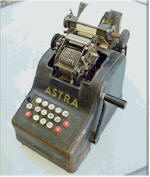 In Germany, an interesting case is the
Astra produced by
Astrawerke in 1922. It was
based on the Dalton machine but the odd digits were in the first row,
folloed by the even digits in the second row, and the zero and
multi-zero keys on the third row. In Germany, an interesting case is the
Astra produced by
Astrawerke in 1922. It was
based on the Dalton machine but the odd digits were in the first row,
folloed by the even digits in the second row, and the zero and
multi-zero keys on the third row.
[1] [3] [5] [7] [9]
[7] [8] [9] In 1927, Sundstrand sold the rights to Underwood-Elliot Fisher Co. and worked for this company until 1949. In 1950 he joined the Victor Adding Machine Co. Sundstrand keyboard design became the de-facto standard for mechanical calculators, and then it was also adopted by handheld electronic calculators when they started to appear in the market at the beginning of the 70's.
The limitation of the mechanical technology has prevented from thinking about other ways to enter numbers that were not keying a sequence of digits, but our mind does not conceive a number as a sequence of digits. We live in the year “two thousand seven” not in the year “two zero zero seven”.
H for “Hundred” Yes, we live in the year “2T7.” The usage of Verbal Numerals requires a procedure to convert them into its corresponding sequence of digits. This method covered by US Patent 5,623,433, extends a normal keyboard with keys for "Hundred," "Thousand" and "Million," so that the number can be entered as it is pronounced. This procedure can be used for all major languages, and have the following advantages: •Consistent with the way the mind conceive a number. •In many cases requires less symbols to be entered. •Avoids mental conversion into a sequence of digits. •Easily adapted as input means in electronic devices. •Does not replace but expand the traditional input procedures |
| This innovation will made it easier the way we have been entering numbers for the last 93 years, since Oscar Sundstrand invented the standard calculator keyboard. |
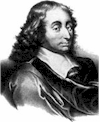 Before
1886, calculators didn’t have keyboards. They were based on the
Pascaline, a calculating device invented by
Before
1886, calculators didn’t have keyboards. They were based on the
Pascaline, a calculating device invented by
 It
was 1672 when the famous German polymath, mathematician and philosopher,
It
was 1672 when the famous German polymath, mathematician and philosopher,
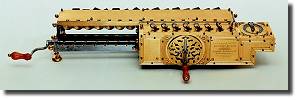


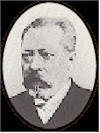 A
few years later, in 1878,
A
few years later, in 1878,
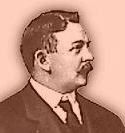

 A
significant departure from the popular
A
significant departure from the popular
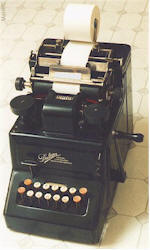
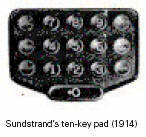
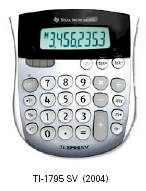 Since
then, electronic calculators have evolved in many different ways,
displays changed from LED’s to LCD’s, and every imaginable combination
of shapes, material and colors have been used. However, they have all
inherited the basic 10-key design from Sundstrand's mechanical
calculator.
Since
then, electronic calculators have evolved in many different ways,
displays changed from LED’s to LCD’s, and every imaginable combination
of shapes, material and colors have been used. However, they have all
inherited the basic 10-key design from Sundstrand's mechanical
calculator.